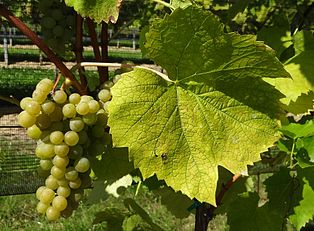Muscaris
| Muscaris | |
|---|---|
| Synonyms | no |
| Breeding number | FR 493-87; Freiburg 493-87 |

|
|
| Art | Grape vine ( Vitis vinifera subsp. Vinifera ) |
| Berry color | greenish yellow |
| use | |
| origin | Germany |
| breeder | Norbert Becker |
| Institute | State Viticulture Institute Freiburg |
| Breeding year | 1987 |
| VIVC no. | 22628 |
| ancestry | |
|
Cross of |
|
| List of grape varieties | |
Muscaris is a fungus- resistant white wine variety bred in 1987 . It has a high to very high tolerance to fungal diseases and thus enables a reduction in the use of chemical pesticides.
Origin, descent
( Merzling x ( Zarya Severa x Muskat-Ottonel ) (vulgo Solaris)) x Gelber Muskateller .
Muscaris been on the State Weinbauinstitut Freiburg by Norbert Becker from the varieties Solaris (as parent variety, ♀), and Muscat (as father places ♂) crossed . The Solaris grape variety, in turn, emerged from the parent varieties Merzling (as mother variety , ♀) and Gm 6493 (as father population, ♂). Despite a small proportion of the Vitis amurensis grape variety over the Gm 6493 variety, Muscaris does not belong to the hybrid grape family .
To cross this variety, Norbert Becker used the parent varieties Gelber Muskateller as father and the variety Solaris as mother, which in turn emerged from the crossing of Merzling × Gm 6493 (or Geisenheim 6493). Gm 6493 was a seedling population that was crossed in 1964 by Vilém Kraus in what was then Czechoslovakia from the grape varieties Zarya Severa x Muscat-Ottonel . Vilém Kraus offered the seedlings to Helmut Becker (1927–1990), who worked at the Geisenheim Research Station at the time, who recognized the quality of this material and further processed it in breeding in progeny tests.
Norbert Becker erroneously researched the Saperawi Severni grape variety instead of Zarya Severa as the mother variety ♀ for the seedling population, which was only given the designation Gm 6493 in Geisenheim, when Vilém Kraus was crossed in 1964 . A detailed follow-up research by Norbert Becker's successor Volker Jörger together with colleagues from the Geisenheim research institute was able to reveal the error and true parenthood has been considered certain in specialist circles since 2003.
Ampelographic features
- The tip of the shoot is lightly hairy woolly.
- The shoots are strong.
- The sheet is pentagonal with 3–5 lobes and has a V-profile; The leaf blade is slightly waffled and slightly blistered; the stalk bay is open to slightly open with a V-shaped base.
- The grape is medium to large with few compact medium-sized berries.
Maturity: medium
properties
The high to very high tolerance to the fungal diseases real powdery mildew as well as downy mildew and botrytis is advantageous . Because of the higher acid content, it is suitable for sparkling wine production. The winter frost resistance is good. The yield is medium, but a little unstable.
The disadvantage is the strong growth on vigorous locations - increased foliage work necessary. The variety has an increased need for the nutrient> magnesium - otherwise deficiency symptoms.
Wine
The white wines are lean to full-bodied, have a strong acidity and an intense bouquet with notes of nutmeg .
Web links
- Information sheet on the homepage of the State Viticulture Institute Freiburg (PDF file; 86 kB)
- Piwis as a grape variety wine , further progress for fungus- resistant grape varieties, Agrar-Server Land Steiermark
literature
- Ferdinand Regner , Karel Hanak, Cornelia Eisenheld: Directory of Austrian quality wine grape varieties and their clones , 2nd edition 2015, HBL and BA for WB, Klosterneuburg, S25.
- Karl Bauer, Ferdinand Regner , Barbara Friedrich: Weinbau , avBuch im Cadmos Verlag, Vienna, 9th edition 2013, ISBN 978-3-7040-2284-4 .
- Hans Ambrosi , Bernd HE Hill, Erika Maul, Erst H. Rühl, Joachim Schmid, Fritz Schuhmann: Color atlas grape varieties 3rd edition, Eugen Ulmer, 2011, ISBN 978-3-8001-5957-4 .
- Walter Hillebrand, Heinz Lott, Franz Pfaff: Paperback of the grape varieties. 13th, revised edition, Fachverlag Fraund, Mainz 2003, ISBN 3-921156-53-X .
Individual evidence
- ↑ Information on the homepage of the Freiburg State Viticulture Institute
- ↑ a b Karl Bauer, Ferdinand Regner , Barbara Friedrich: Weinbau , avBuch im Cadmos Verlag, Vienna, 9th edition 2013, ISBN 978-3-7040-2284-4 .